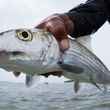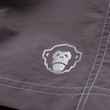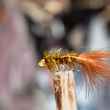More than half-a-century ago—1965, to be exact—my dad took me on my first Canadian fishing trip. Grandpa Davis came, too. Our destination was Lake of the Woods, a place that loomed so mythically in my eight-year-old imagination that its shorelines might have been cobbled with gold.
It was a long drive to Kenora, Ontario. “Ticket to Ride” was in heavy rotation on AM radio, and its association with that trip is undoubtedly the biggest reason it’s always been my favorite Beatles song. Still, the memories of the fishing burn brightest. There were walleyes galore, willing northern pike in every weedy bay … but the fish that eclipsed all the rest was the smallmouth bass I hooked one sunny afternoon. I’d tossed my lure toward a rocky point and POW!, had the hardest strike I’d ever felt.
I’ll never forget the way that bass erupted from the water, throwing spray and seeming to walk on its tail; I’ll never forget my elation when Alec, our Ojibwe guide, secured it by the bottom lip and held it up, dripping, for all of us to see.
I’ll never forget the lure I used to catch that bass, either: a Mepps spinner. Like “Ticket to Ride,” it’s held a special place in my affections ever since.
If there was a Mt. Rushmore for artificial lures, the Mepps spinner would be on it. The Mepps is one of the best-selling lures of all time, and for good reason. There’s literally no gamefish in fresh water, and very few in salt, that can’t be caught on it. Big ones, too: The list of record-class fish caught on the Mepps fills pages. Invented by a French engineer in 1938 (making 2018 its 80th birthday), the Mepps has been called “the most successful French import since Brigitte Bardot.”
Actually, I don’t know for a fact that anyone’s called it that. But if they didn’t, they should have.
The Mepps’s roots may be in France (we graybeards remember when the lures were commonly known as “French spinners”), but the place where the Mepps legend truly began, and where the Mepps spinner became a worldwide phenomenon, is about as far from France—culturally if not necessarily geographically—as you can get.
That place, of course, is Antigo, Wisconsin.
The story goes that one day in 1951 Todd Sheldon, who owned a tackle shop in Antigo, was having a hard time of it on the fabled Wolf River. None of his “old reliables” could tempt a trout. Then he remembered the curiously named spinner that a GI friend and legendary local angler, Frank Velek (a.k.a. Big Frank), had picked up in France and given to him a couple years earlier. Sheldon cast his Mepps “Aglia” spinner into the swirling currents of the Wolf—and the haul of lunker trout he made changed the course of fishing history.
Sheldon asked Velek how to get Mepps spinners to sell in his shop; Velek said he knew a woman. An arrangement was worked out: They sent her nylon stockings from America, she sent them Mepps spinners from France.
It was a simpler time.
Soon Sheldon was selling spinners faster than his “source” could wear out nylons, so he began importing them directly from the manufacturer. By 1956, demand had grown to the point that Sheldon was able to close his retail store, establish Sheldons’, Inc., and focus exclusively on getting Mepps products into American tackle boxes from sea to shining sea.
Today, while the components for Mepps spinners are still manufactured in France (Sheldons’ now owns the factory there), the actual assembly takes place in Antigo, in a 50,000-square foot facility on the north side of town. If you’ve ever driven through on Highway 45, you’ve undoubtedly seen the rustic sign that, among other things, bears the semi-cryptic legend SQUIRREL TAILS WANTED.
This facility also serves as Sheldons’ corporate headquarters, and that’s where I find Josh Schwartz, Communications Director for Mepps and Mister Twister, another iconic brand under the Sheldons’ umbrella. When I express my amazement that Mepps doesn’t “outsource,” he replies “That’s one of the things that makes Mepps unique in the fishing tackle industry. We’ve found over the years that we can better control the entire process if we do it here.”
I follow Josh past a colorful display of the current Mepps product line (mind-boggling in its variety) and into the production area. It’s the proverbial beehive of activity, with skilled craftspeople—all women, as far as I can tell—dexterously assembling Mepps spinners, one at a time. Imagine jewelry making on a grand scale, and you’ll have some idea of the process.
Past the shipping area, where they’re preparing an order for Cabela’s, the outdoor retail giant, we come to the part of the operation that piques my interest most of all.
“Welcome to the Squirrel Tail Department,” smiles Peg Doucette. In her 35th year on the job, Peg doesn’t just head up the Squirrel Tail Department, she is the Squirrel Tail Department.
As I’d learned from Josh, the original Mepps Aglia sported a bare treble hook. Then, in the early 1960s, again while fishing the Wolf River, Todd Sheldon ran into a kid with a stringer of trout all bigger than the ones he’d caught. The kid was using a Mepps—but he’d tied a tuft of squirrel tail to the hook.
After experimenting with different materials and determining that nothing had the same lifelike action that squirrel tail did, Sheldon set out to incorporate this innovation into the Mepps line. It’s not as if you can simply place an order for 100,000 squirrel tails, though. So, the company appealed to the nation’s hunters with this offer: Instead of throwing away the tails from the squirrels you kill, send them to us for “recycling.” Assuming they pass muster, you can have your choice of a cash payment or double that amount in a credit for Mepps merchandise.
And thus another part of the Mepps legend was born. More than 50 years after the squirrel tail “program” began, hunters from all parts of the country continue to send their squirrel tails to Antigo. (In the early years there was a network of squirrel tail “collection points”—sporting goods and hardware stores, typically—but that part of the program fell by the wayside.) The going rate for top-quality fox, black, and grey squirrel tails ranges from twenty to twenty-six cents per tail; red squirrel tails, because of their smaller size, command about half that.

“I’m the judge and jury,” Peg laughs, meaning that she “grades” each and every tail to determine the appropriate compensation. Showing me a box of mixed grey and fox squirrel tails that just came in, she notes “These are large, ‘premium’ tails. We’ll get ten lures from one of these.”
The actual tying of the squirrel tail hair to hooks—“dressing,” this is called—is done by a number of local people who work in their homes, Peg tells me. Before the tails can be handed off, however, they have to be washed, dried, frozen, dehydrated, sorted, measured, and, if necessary, dyed.
“There’s a lot to it,” Peg says, in a bit of classic northern Wisconsin understatement.
I ask if she’s ever gotten a delivery that surprised her. “Well,” she says with a little chuckle, “just the other day someone sent in a bag of whole frozen squirrels. I had to wait until they kind of thawed out, take ‘em out by the garbage, and cut the tails off.”
Before she became the judge and jury of squirrel tails, Peg dressed hooks in her home for 17 years. “There was no road between my home and the office then,” she recalls, “so in the winter I’d come over on my snowmobile.” She hands me a small treble hook dressed with fox squirrel tail—a real thing of beauty. “I tied a few of these this morning just to see if I still could,” she explains.
Back on the production floor, Josh recruits Ruth Prochaska to transform my dressed hook into an actual Mepps spinner—a size 3 Aglia with a Hot Firetiger blade. Working in slow-motion for my benefit, Ruth slides the eye of the hook onto a V-shaped length of stainless steel wire, then squeezes the cylindrical brass “body” down on top of it. This goes into a die where, with the crank of a handle, the body is crimped in place and the excess wire trimmed.
There are four pieces plus the blade left to attach, and, as Ruth notes, “There’s a right way and a wrong way to do it.” Now, displaying the nimble-fingered legerdemain of a magician, she threads the remaining components—one of which is no bigger than a poppy seed—onto the wire, places it into another die, turns the crank, and voila!, the loop necessary to attach lure to line is formed.
Just like that, another Mepps spinner is ready to catch fish—and to create memories.































Comments